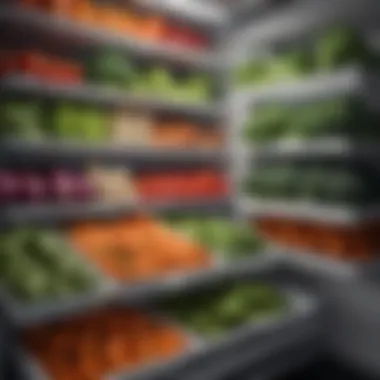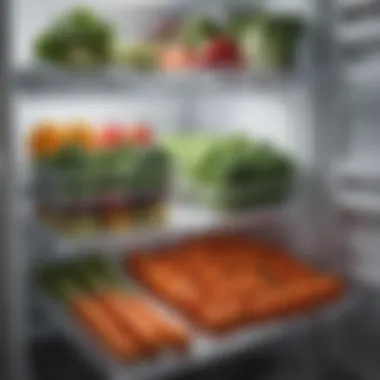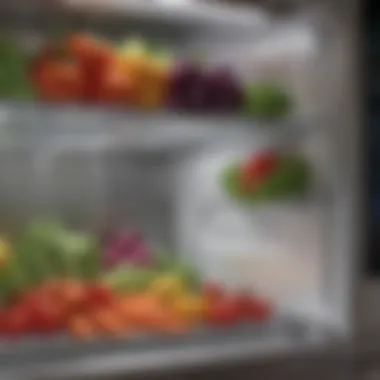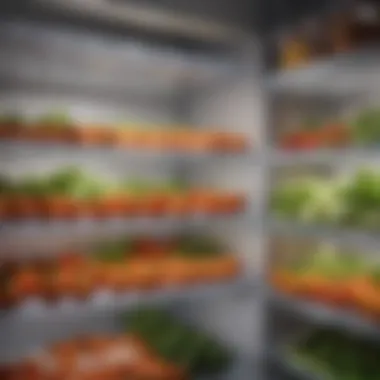Refrigerator Veggie Storage: Keep Freshness & Flavor


Intro
The storage of vegetables in a refrigerator is a crucial component in maintaining their freshness and flavor. Understanding proper techniques can help anyone who enjoys cooking and eating vegetables. By diving into the science behind storage conditions, this article aims to provide readers with the knowledge necessary to enhance the longevity and quality of fresh produce.
Taking into account elements such as temperature, humidity, and individual vegetable requirements, this guide will explore effective storage solutions. Learning these skills not only minimizes waste but also ensures that the nutritional value of vegetables remains intact. The following sections will cover key points such as optimal storage temperatures, moisture management, and organization methods that can transform a typical refrigerator into a haven for fresh vegetables.
Key takeaway: Proper vegetable storage not only preserves freshness but also elevates the flavor and nutritional content of produce.
By comprehensively addressing these aspects, readers can expect to gain a better understanding of how to store vegetables effectively. Whether you are a seasoned chef or an occasional cook, these insights will be of great relevance.
Understanding Refrigerator Storage Dynamics
Refrigerator storage is not just about placing vegetables on a shelf and closing the door. It involves understanding several factors that affect the freshness and flavor of produce. The dynamics of refrigerator storage encompass temperature, humidity, and the layout of the appliance, all of which play crucial roles in preserving quality.
Being aware of how these elements interact can lead to significantly prolonged shelf life for your vegetables. The benefits of optimizing your storage techniques are manifold, including reduced food waste, enhanced taste, and better nutrition. Struggling with wilting, spoilage, and loss of flavor can often be a symptom of improper storage decisions.
As we delve into the specifics, we will highlight how temperature control and humidity management impact the freshness of your vegetables. Understanding these dynamics is essential for any food lover aiming for optimal storage practices in their refrigerator.
The Role of Temperature in Produce Freshness
Temperature control is fundamental to maintaining the freshness of your vegetables. Different types of produce have varying optimal temperature ranges, which can determine their longevity. Typically, most vegetables thrive best in a range of 32°F to 40°F (0°C to 4°C). This range slows down respiration rates and enzymatic reactions, both of which can lead to spoilage.
Here are key points about temperature's influence on vegetable freshness:
- Leafy greens like spinach or kale often perish quickly if not kept at the right temperature. They prefer cooler settings to help retain their crispness.
- Root vegetables such as potatoes and carrots can tolerate slightly warmer temperatures but should still be kept cool to prevent sprouting and decay.
- Ethylene producers, like ripe bananas, release a gas that can accelerate ripening and spoilage in nearby ethylene-sensitive vegetables.
Maintaining a consistent temperature within the refrigerator is crucial; fluctuations can lead vegetables to become rubbery or mushy. Regularly monitoring your refrigerator's temperature settings can mean the difference between vibrant produce and things that spoil too soon.
Humidity Levels and Their Impact
Humidity levels are just as important as temperature when it comes to storing vegetables. Vegetables need moisture to stay fresh, but too much humidity can lead to mold and decay. Understanding the delicate balance of humidity can drastically affect how well your produce holds up over time.
Refrigerators typically feature crisper drawers designed to control humidity. Here’s how to make effective use of these spaces:
- High humidity is beneficial for leafy greens and herbs. Use the crisper drawer that retains moisture, often labeled as “vegetable” storage.
- Low humidity works well for root vegetables and others that prefer drier conditions. Here, air circulation is key to preventing rot.
To sum up, managing humidity effectively can help your vegetables retain their flavor and nutritional value. Knowing when to adjust settings or where to store specific items can enhance freshness significantly.
"Understanding temperature and humidity dynamics in your refrigerator can lead to lasting improvements in vegetable storage."
By mastering these basic principles, one can significantly enhance the quality of stored vegetables.
Organizing Your Refrigerator for Vegetables
Organizing your refrigerator for vegetables is a critical aspect of ensuring longevity and flavor in fresh produce. A well-organized refrigerator optimizes the storage environment, allowing for better temperature control and moisture management. By taking time to arrange vegetables properly in their designated areas, you not only extend their shelf life but also enhance their taste and nutritional value. Proper organization reduces waste, as it is easier to locate items and prevents produce from hiding in the back and spoiling.
Understanding The Crisper Drawer Functionality
The crisper drawer is the heart of vegetable storage in most refrigeration units. This compartment is specifically designed to maintain an appropriate humidity level for fruits and vegetables. Generally, you will find two types of crisper drawers: one for high-humidity foods, such as leafy greens, and another for low-humidity items, like apples and pears.
Setting the drawer to high humidity prevents moisture loss in leafy greens, prolonging freshness. Conversely, low-humidity settings allow ethylene-producing fruits to release gases without affecting nearby veggies. To maximize the crisper function, avoid overcrowding it; this can lead to uneven airflow and promote spoilage. Additionally, utilize perforated bags or produce containers to encourage airflow while retaining some moisture.


Utilizing Shelf Space Effectively
Shelf space in a refrigerator is often underutilized or misaligned, leading to potential spoilage. Different vegetables have specific storage requirements, so it is essential to categorize them accordingly. Higher shelves tend to be warmer, making them suitable for root vegetables like carrots and potatoes. The middle shelves usually offer moderate temperature and can accommodate a variety of vegetables.
Organizing by use or cooking preferences can streamline meal prep too. For example:
- Herbs and Greens: Store near the top for easy access to fresh flavor.
- Root Vegetables: Keep on lower shelves, where the temperature is warmer.
- Soft Vegetables: Place these in the center where conditions are milder but still cool.
Clear containers or bins can increase visibility and ease of access, helping you to quickly spot what you need. Keeping similar-size items together also minimizes airspace, ensuring they stay within their ideal storage conditions. This method of organization not only maintains freshness but also contributes to a more efficient use of your refrigerator.
Vegetable-Specific Storage Techniques
Vegetable-specific storage techniques are crucial for maintaining the quality and taste of fresh produce. Each type of vegetable has unique needs regarding temperature, humidity, and even the manner of storage. Recognizing these requirements can lead to longer-lasting freshness, enhanced flavor, and optimal nutritional value. Implementing tailored approaches contributes to reducing waste and ensuring that vegetables are at their best when consumed.
Leafy Greens: Maximizing Crispness
Leafy greens like spinach, lettuce, and kale require careful handling to retain their crispness and nutritional content. First and foremost, they should be stored in a refrigerator setting around 32°F (0°C) to 36°F (2°C). This temperature minimizes moisture loss, crucial for crispy greens. When storing, remove any damaged leaves and avoid washing them before storage, as excess moisture can promote spoilage. Instead, place greens in a perforated plastic bag or wrap them in a dry paper towel before putting them in the crisper drawer. This dual approach helps maintain humidity while allowing for some air circulation.
Root Vegetables: Longevity Strategies
Root vegetables, such as carrots, potatoes, and beets, have a different storage profile. They benefit from a cool but not freezing environment. The ideal temperature for these vegetables is between 32°F (0°C) and 40°F (4°C). Avoid storing them near fruits that emit ethylene gas, such as apples or bananas, as this can lead to sprouting or decay. Instead, use burlap sacks or cardboard boxes, with the exception of potatoes, which should be kept in a dark, well-ventilated space. Regular checks for rot are essential to ensure longevity and quality.
Cruciferous Vegetables: Retaining Nutrients
Cruciferous vegetables, such as broccoli, cauliflower, and Brussels sprouts, hold substantial nutritional value, but can degrade quickly if not stored correctly. Like leafy greens, these vegetables thrive at a temperature range of 32°F (0°C) to 36°F (2°C). Wrapping them loosely in damp paper towels can help retain moisture. Store them in an airtight container to prevent them from wilting and to limit exposure to ethylene gas. Consume them within a few days for maximum nutrient retention. A good practice is to place them in the crisper drawer, separate from other produce to avoid cross-contamination of odors.
Soft Vegetables: Handling with Care
Soft vegetables like tomatoes, cucumbers, and mushrooms require gentle handling during storage. They are susceptible to bruising and damage, so avoid stacking and pressing them against each other. Stored at temperatures around 45°F (7°C) to 50°F (10°C), they should not be overly cold as this can alter their flavor profile and texture. Place them in a breathable container, like a paper bag or a well-ventilated basket, to help maintain their natural moisture and prevent condensation. Check regularly for signs of softening to ensure optimum freshness.
Bell Peppers and Tomatoes: Ideal Conditions
Bell peppers and tomatoes have specific temperature preferences for ideal storage. Store bell peppers in the refrigerator in the crisper drawer, ideally at temperatures around 45°F (7°C) or so. They remain fresher when kept whole rather than sliced. Tomatoes, conversely, are best at room temperature until they are fully ripe. After ripening, they can be placed in the refrigerator to extend their life but know that this may cause textural changes. Look for punctures or blemishes during storage checks, as these can lead to quick spoilage. By maintaining specific environments for these vegetables, you can enjoy their vibrant flavors for longer.
The Science of Ethylene Gas
The role of ethylene gas in vegetable storage is often overlooked despite its significant impact on freshness and flavor. Ethylene is a natural plant hormone released by various fruits and vegetables, and it plays a crucial role in the ripening process. Understanding how ethylene gas works can significantly enhance your ability to store vegetables effectively. By recognizing how to manage ethylene-producing and ethylene-sensitive produce, you can maintain optimal quality in your refrigerator.
Understanding Ethylene Producers vs. Sensitives
Certain vegetables and fruits act as ethylene producers. This includes items like apples, bananas, and tomatoes. They release ethylene gas, which accelerates the ripening of nearby produce. On the other hand, some vegetables are ethylene-sensitive. This includes leafy greens, cucumbers, and bell peppers. Exposure to ethylene can lead to spoilage or accelerated decay in these sensitivities.
It's essential to separate ethylene producers and ethylene-sensitive vegetables within your refrigerator. For instance, keep tomatoes and bananas away from cucumbers and lettuce. This separation may help in prolonging their shelf life and preserving their quality. Using dedicated drawers or containers for each type can help facilitate this.
"Managing ethylene gas effectively transforms the refrigerator into an environment that maintains the integrity of fresh produce."
Managing Ethylene Release in the Refrigerator
To manage ethylene effectively, attention to storage techniques is vital. Here are several tips to consider:
- Utilize Crisper Drawers: Many refrigerators are designed with crisper drawers that control humidity. Use these drawers for ethylene-sensitive vegetables, ensuring they are stored at an appropriate moisture level while minimizing ethylene exposure.
- Temperature Control: Storing ethylene producers at the right temperature can reduce their ethylene production, minimizing the effect on sensitive items. Keep producers slightly cooler, if possible.
- Monitor Freshness: Regularly check on stored produce. Remove spoilage quickly to prevent ethylene gas from influencing other vegetables.
- Use Well-Ventilated Containers: Consider using breathable containers with perforations or mesh that allow airflow, helping to disperse ethylene buildup while keeping produce fresh.
By understanding ethylene dynamics and applying careful management techniques, you can effectively enhance vegetable storage quality and longevity.


Best Practices for Washing and Preparing
Washing and preparing vegetables are critical steps that can greatly affect their freshness and flavor after storage. Proper washing removes dirt, pesticides, and bacteria, while adequate preparation ensures that vegetables maintain optimal texture and nutritional value during storage. Understanding these practices is essential for anyone who desires to maximize the quality and longevity of their produce.
Washing Vegetables: When and How
Washing vegetables properly is fundamental to prevent contamination and to preserve their essence. The best time to wash vegetables depends on how you intend to store them. It is generally advisable to wash vegetables right before you use them. Washing too early can lead to moisture buildup, which fosters mold growth and spoilage.
When washing, use cold or lukewarm water. Avoid using soap or any detergents as they can leave harmful residues. For firm vegetables like carrots or potatoes, a scrub brush can help remove stubborn dirt. Leafy greens should be soaked in a bowl of water and gently agitated. This helps to remove hidden dirt and little insects. After washing, dry the vegetables with a clean towel or allow them to air dry to prevent excess moisture when storing.
Preparing for Optimal Storage
Preparing vegetables right for storage can affect not only their preservation but also their convenience for future meals. First, consider trimming any damaged or wilted parts before storage. For some vegetables, like broccoli or cauliflower, cutting them into smaller pieces can promote even cooling and make them ready for cooking later.
Using appropriate storage methods is equally essential. Some vegetables benefit from being left whole, while others are better stored cut. For example, sliced bell peppers should be stored in an airtight container to retain moisture without becoming soggy. Additionally, wrapping vegetables like asparagus in a damp paper towel before sealing them in a bag can help maintain moisture levels.
Be mindful of storing vegetables in the right compartments of your refrigerator. The crisper drawer is specifically designed to maintain humidity, which is beneficial for many fresh vegetables. Organizing the vegetables based on their moisture needs will also help in maintaining their freshness.
"Proper washing and preparation practices are not just routine; they can boost the longevity and flavor of your vegetables significantly."
In summary, washing vegetables correctly and preparing them with care plays an integral role in vegetable storage. Ignoring these practices could lead to diminished quality and flavor of your produce. Knowing when to wash and how to prepare vegetables ensures they will remain fresh and delicious, contributing positively to your overall culinary experience.
Common Mistakes in Vegetable Storage
Proper storage of vegetables is paramount for maintaining their freshness and flavor. In this section, we will discuss common mistakes that people make when storing vegetables in the refrigerator. Addressing these missteps can lead to better preservation of quality, longer shelf life, and ultimately, less food waste. Being aware of these pitfalls is crucial for any food lover who values the taste and nutrition of their produce.
Overcrowding the Refrigerator
One of the most frequent mistakes is overcrowding the refrigerator. When vegetables are packed tightly together, air circulates poorly, leading to uneven temperatures. This inconsistency can cause some items to spoil faster than others. It also makes it harder to monitor the freshness and quality of each vegetable.
Moreover, overcrowding can lead to bruising. When vegetables are pressed against each other, they can be damaged, depleting their nutritional value and causing quicker spoilage. Leaving adequate space between items allows for better airflow and keeps vegetables crisp and fresh.
Here are some tips to avoid overcrowding:
- Arranging vegetables in layers: Sort based on type and size.
- Utilize baskets or bins: Keep similar vegetables grouped together.
- Regularly check stock: Remove any spoiled items immediately to create more space.
- Store in smaller portions: This makes it easier to manage and identify the freshness of each batch.
Incorrect Placement in the Refrigerator
The placement of vegetables within the refrigerator plays a significant role in their longevity. Each section of the fridge offers different temperatures, which can drastically affect how long produce remains fresh. For instance, the crisper drawers are designed to maintain optimal humidity levels, making them ideal for storing vegetables. However, if vegetables are placed on the shelves or, even worse, in the door, they are exposed to fluctuating temperatures. This can accelerate spoilage processes.
Here are some recommendations for proper placement:
- Use crisper drawers: They are specifically made for vegetables and help reduce moisture loss.
- Store green vegetables at the bottom: These generally prefer cooler environments.
- Avoid the fridge door: It's the warmest part of the fridge due to frequent openings and closings.
- Arrange heavier items above lighter ones: This prevents squashing and maintains structural integrity.
Ultimately, understanding these common mistakes in vegetable storage can significantly enhance the quality of your produce. By avoiding overcrowding and ensuring correct placement, you preserve not only the physical health of your vegetables but also their taste and nutrition.
The Role of Containers in Vegetable Preservation
Containers play a crucial part in how well vegetables maintain their freshness and flavor while stored in the refrigerator. The material, size, and type of container can significantly influence the storage life and quality of vegetables. Using the right containers helps create an optimal environment that regulates moisture levels and withstands temperature fluctuations, both of which are paramount for prolonged freshness.
Benefits of Proper Containers


- Moisture Control: Certain containers are designed to retain moisture, which is necessary for some vegetables. Others allow for evaporation, preventing excess moisture that can lead to spoilage.
- Airflow Management: Breathable containers can aid in maintaining air circulation, reducing the risk of mold and decay for sensitive produce.
- Protection from Ethylene: Selecting containers that can contain ethylene gas helps limit exposure to ethylene-sensitive vegetables.
When vegetables are adequately protected by well-chosen containers, it minimizes food waste and enhances culinary experiences by ensuring that fresh flavor is preserved until the time of consumption.
Choosing Appropriate Storage Containers
The selection of storage containers requires careful consideration. Different materials, like glass, plastic, and ceramic, each have their merits and demerits. Glass containers, for instance, do a great job of keeping food fresh and are non-reactive. Plastic containers are lightweight and provide a good seal but can leach chemicals over time. A mix of these materials can offer the best storage solution for various vegetables.
Factors to Consider
- Size: Choose containers that fit the volume of vegetables you store. Too much empty space can promote air circulation that stimulates spoilage.
- Seal Type: Look for containers that offer airtight seals for moisture-sensitive produce, while others with breathable designs are suitable for items needing air.
- Transparency: Transparent containers help you quickly identify contents without having to open them, minimizing exposure to air.
Tips for Airtight and Breathable Storage
Utilizing both airtight and breathable storage options is key to vegetable preservation. The goal is to tailor container choice according to specific vegetable needs.
- Airtight Containers: Best for leafy greens and soft vegetables, such as lettuce and spinach. Sealing them in these containers prevents excess moisture loss, preserving their crispness and flavor.
- Breathable Storage: Suitable for hardier vegetables likes carrots and bell peppers. These should be stored in perforated bags or containers that allow for air exchange, thus reducing condensation that fosters decay.
Important point: Mixing types may be effective. Soft vegetables can share shelf space with root vegetables if divided by breathable materials, allowing both to be stored without compromising quality.
When applied correctly, these strategies around container usage contribute significantly to maximizing the lifespan and delightful taste of vegetables, reinforcing the idea that thoughtful storage practices lead to better food experiences.
Monitoring Freshness: Techniques and Indicators
Monitoring the freshness of vegetables is crucial for maintaining their quality and flavor. It directly impacts the eating experience and health benefits derived from consuming fresh produce. Being aware of how to identify freshness can prevent food waste, save money, and ensure that meals are nutritious and enjoyable. This section outlines the methods and indicators one can use to assess the condition of vegetables held in the refrigerator.
Signs of Spoilage to Identify
Recognizing spoilage is essential for effective vegetable storage. Several indicators can help in identifying a vegetable that may no longer be fresh:
- Discoloration: A noticeable change in color can signify spoilage. For example, leafy greens losing their vibrant hue may indicate they are past their best.
- Texture Changes: Fresh vegetables should maintain their firmness. If you encounter softness or mushy spots, this is a clear sign they are deteriorating.
- Odor: A sour or off smell is often an indicator of spoilage. Fresh vegetables should have a mild and natural scent.
- Wilting: Leafy greens and herbs may begin to wilt when freshness declines.
- Mold or Slimy Coating: Any visible mold or a slimy texture should warrant immediate disposal of the affected vegetable.
Being observant of these signs can significantly prolong the freshness of the produce on hand. Furthermore, educating oneself on how each vegetable behaves in storage can enhance this ability.
Best Before vs. Use By Dates
Understanding date labels on packaging can prevent confusion regarding the safety and quality of vegetables. Two commonly used terms are "Best Before" and "Use By" dates. Each serves a different purpose:
- Best Before Dates: This label indicates the period during which the produce is expected to maintain optimal quality. Foods can still be consumed after this date, assuming they show no signs of spoilage. However, the flavor and texture may not be as ideal.
- Use By Dates: In contrast, this label usually appears on perishable items and indicates the last date safe to consume the product. Consuming food past this date can pose health risks.
It is crucial to note that date labels are not universally regulated. Thus, relying solely on them without observing freshness indicators may lead to food waste.
Keeping a keen eye on these dates, coupled with observation of physical attributes, allows for more informed decisions when it comes to vegetable quality. This understanding is essential for any food lover who values freshness.
End: Strategies for Effective Refrigerator Veggie Storage
In reviewing the diverse aspects of refrigerator veggie storage, it's important to synthesize the key strategies that contribute to maintaining freshness and flavor. This not only elevates the eating experience but also ensures that vegetables provide their maximum health benefits.
Understanding the nuances of temperature regulation is paramount. Each vegetable has its own optimal storage temperature. For example, leafy greens thrive at cooler temperatures, whereas root vegetables fare better in slightly warmer environments. Having a well-designed refrigerator with adjustable temperature settings can greatly aid in tailoring the conditions for various types of produce.
Humidity plays a crucial role as well. Crisper drawers are specifically designed to control humidity levels. Keeping produce in these drawers—especially fruits and vegetables that are sensitive to ethylene gas—can help in prolonging their life. Additionally, knowing which vegetables emit ethylene and which absorb it allows for a more strategic arrangement within the refrigerator.
Make sure to store vegetables properly, considering the type of storage containers used. Choosing breathable containers for items like potatoes or onions helps to prevent moisture buildup, while airtight containers are better suited for washed and prepped vegetables. A periodic assessment of your storage practices is essential.
Monitoring freshness indicators is another critical strategy. Knowing when a vegetable has reached its peak freshness—or when spoilage signs appear—can guide more efficient consumption and waste reduction. For instance, soft spots on tomatoes or wilting on greens are telltale signs that adjustments in storage practices may be necessary.
"Effective storage not only enhances flavor but also ensures nutrition is retained, making it a vital aspect of meal planning."
Implement these strategies to unlock the potential of your refrigerator and enrich your culinary experiences.















